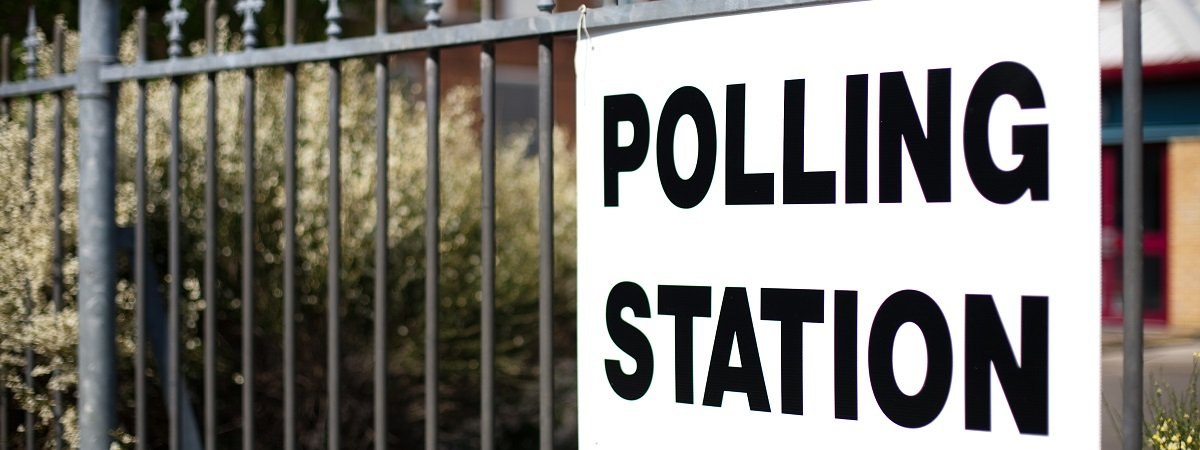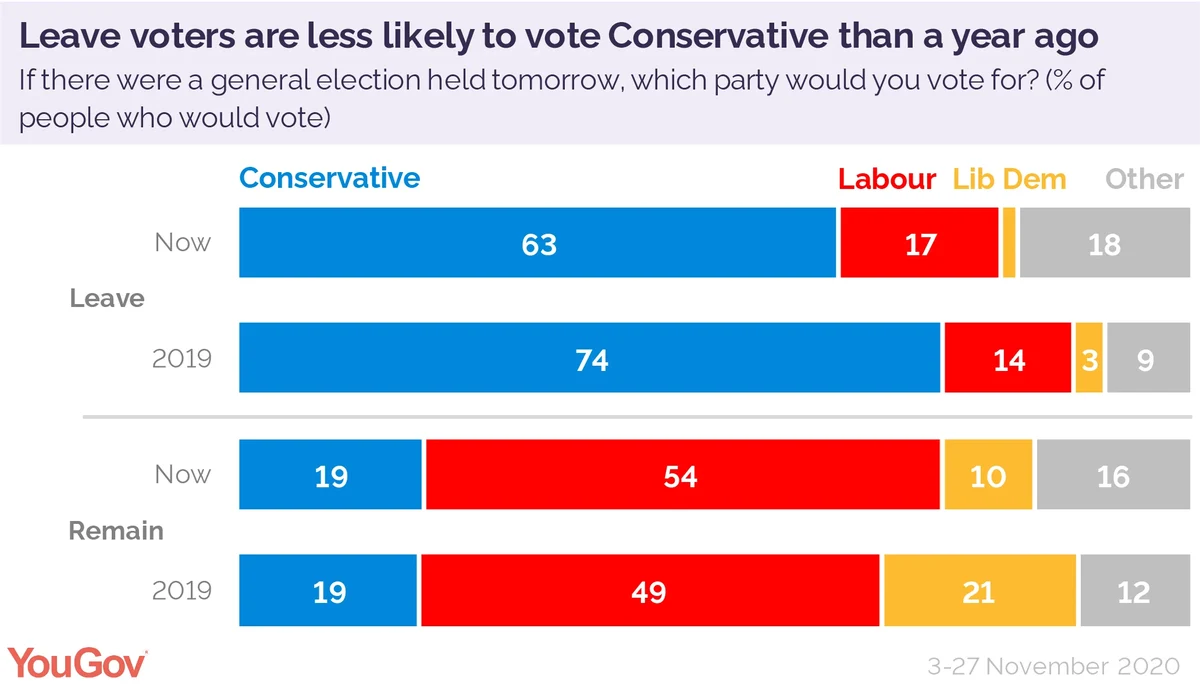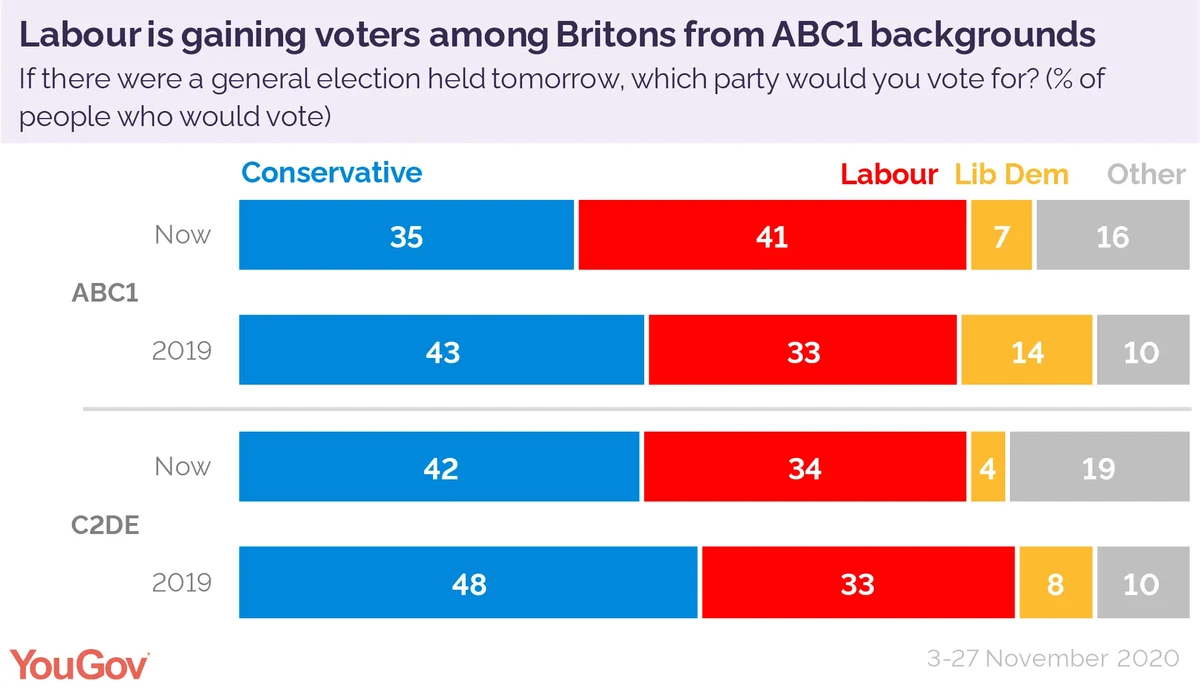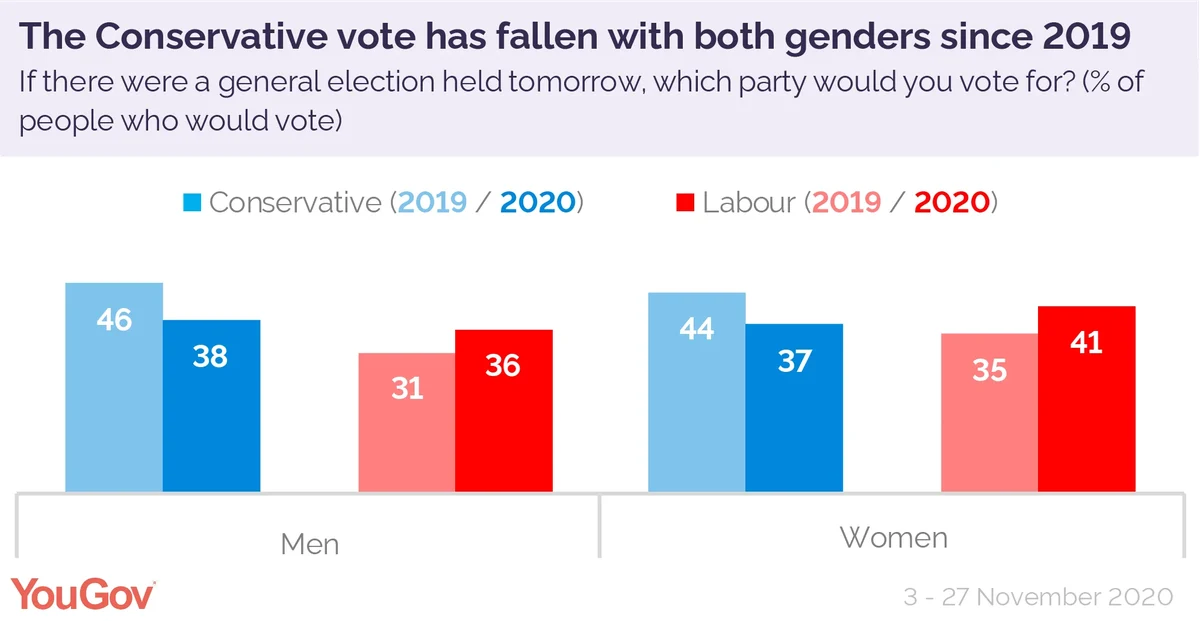
How voters have moved in the year since the election
After such a turbulent period, Boris Johnson may find it hard to believe that just a year ago he was celebrating an emphatic election victory, gaining an 80-seat majority and finishing 12 points ahead of Labour.
At the start of the 2020 a combination of getting a Brexit deal through the Commons and an opposition searching for a new leader meant the Conservatives enjoyed brief honeymoon period and a poll lead of around 20 points. This then rose through the early phase of the COVID-19 crisis to a peak of 24 points at the start of April. However, amid increased pessimism of the government’s handling of the pandemic this has dwindled, and the two main parties are neck-and-neck.
To look more into how different voter groups have moved since the election, YouGov collected data from a representative sample of over 16,000 British adults during November.
We find that Labour is holding on to slightly more of its 2019 voters (85%) than the Conservatives (82%). The Tories have lost a decent chunk (7%) of their 2019 voters to the Brexit Party and – possibly more concerning for them – a similar proportion (6%) directly to Labour.
However, arguably the key reason for Labour’s improvement in the polls is that a great many 2019 Liberal Democrats (40%) say they would vote Labour if there was an election tomorrow. This is compared with just 9% who have switched allegiances to the Conservatives and 42% saying they’d stick with Sir Ed Davey’s party.

Leave and remain
The 2019 general election was dominated by Brexit and a notable factor in the Conservative victory was that the party won over 74% of leavers. By contrast, Labour picked up just 14% of these voters. While Labour secured the largest chunk of the remain vote, its lead was far less dominant – picking up 49% of them, with the Lib Dems picking up 21%, a similar proportion to the Conservatives (19%).
One year on, the Conservative vote share among leavers has dropped to 63%, with 17% now saying they’d vote Labour. Amongst Remainers, slightly more (54%) would now vote Labour, with the Tories staying on 19% but the Lib Dems’ support halving to just 10%.
Since the election, Conservatives and Labour remainers are more likely than their leavers to have stuck with their party. The Tories are holding on to 86% of their remain voters compared to 81% of their leave voters. Similarly, Labour are maintaining the support of 87% of their remain voters and 81% of their Leave voters.

This is likely to pose a bigger challenge for the Conservatives than Labour as its pool of leave voters is much bigger than Labour’s, while Labour’s pool of remain voters is much bigger than the Tories’.
Social grade
Perhaps the most striking demographic change is between social grades. In the 2019 general election, the Conservatives outperformed Labour across all social grades. The party also performed better among C2DE voters than those in the ABC1 category, countering the historical narrative of Labour being the party of the working class and the Tories the party of the middle class.
One year on, we see further realignment. ABC1 voters are swinging to Labour in higher numbers than those in the C2DE category. At the election, the Conservatives led Labour 43% to 33% among the ABC1 group, but now Sir Kier Starmer’s party is ahead by 41% to 35%.
While there has been a move away from the Tories among those in the C2DE social grade, the shift is smaller. The Conservatives are now on 42% with this group, down from 48% in the election, while Labour are on 34%, up just a point.

Age and gender
Over the last few elections we’ve consistently seen that age is a key dividing line in British politics, with younger people being more likely to vote Labour and older people tending to support the Conservatives. While this still remains the case, Labour have made gains across all age groups over the past year.
In the 2019 General Election, the Conservatives held a 47-point lead among voters aged 65 and over. This lead has now fallen to 35 points. At the other end of the spectrum, Labour has improved its lead over the Conservatives amongst 18-24-year-olds from 35 points last year to 42 points now.
As at the 2019 election there is also a small gender gap, with the Conservative lead over Labour falling by 13 points amongst both men and women. The Tories still maintain a narrow advantage among men (38% to 36%) but Labour now leads among women (41% to 37%).


It’s important to remember that the next election could be as far as four years away and any predictions made today about December 2024 have the potential to look as daft in retrospect as those predicting that 2020 was going to be a fantastic year for Britain.
What might concern the Government one year in though, is that is that there isn’t a single demographic group tracked by YouGov that have swung towards the Tories over the last year. Of course they have time on their side but if they are to win back their lost voters and regain a comfortable lead in the polls, the Tories are going to need to cast their net quite wide.